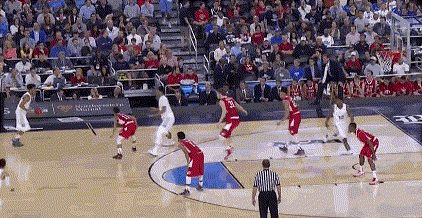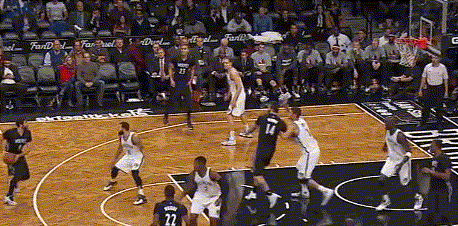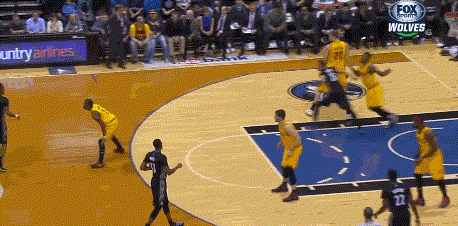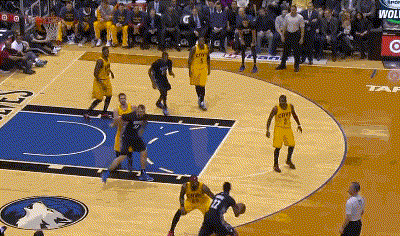By Zach Bennett
Most pundits believe the Minnesota Timberwolves will select Jahlil Okafor or Karl Anthony-Towns with the No. 1 pick in the NBA Draft. And while compelling arguments can be made in favor of both players, neither is without flaw.
Towns, though still an unproven prospect, possesses physical attributes similar to those considered prototypical, modern NBA centers and forwards. He very well could become an impact player at both ends of the floor, eventually, but skeptics will point out that limited production at the collegiate level provokes concern.
Limited production during one season at Kentucky makes Towns considerably arduous to evaluate. He played 823 minutes over the course of 39 games, averaging just 10 points and 7 field goal attempts per game. In addition, although possibly not a huge red flag, Towns fouled out six times last season. Despite an unparalleled physical stature, the not-so-demanding workload is troublesome when considering how Towns will hold up over the course of an onerous 82-game season.
As Wolves and NBA mind Tim Faklis points out, Okafor turned back the clock with brilliance in the post during his one season at Duke. Opponents repeatedly did everything possible to slow down Okafor, using various zone schemes and sending double-teams from all directions, often times to no avail. Although, many question how effective his skills will be in today’s NBA.
While Towns is unquestionably an enticing talent, president-coach Flip Saunders supposedly prefers Okafor — an unpopular opinion, to put it kindly, among pundits throughout the Twitterverse. Potentially palpable evidence supporting this notion is Saunders’ relationship with Okafor’s agent, Bill Duffy. Saunders and Duffy played college ball together at the University of Minnesota. (Duffy, by the way, also represents Zach LaVine and Andrew Wiggins.)
Although it will anger those literally petitioning in favor of Towns; Okafor is better suited for a role within Saunders’ system and would immediately help the Wolves improve at the offensive end.
***
Okafor is a remarkably skilled offensive player, but certain aspects of his game must be acknowledged as troublesome; he shot 51 percent from the free throw line last season; he’s not a very good outside shooter, and there are concerns about his effort and commitment on the defensive end.
Obviously, the poor free throw shooting is not ideal, which can likely be attributed to his abnormally large hands. After many, many hours watching film and reading scouting reports, I feel confident in saying his form is functional, the ball just doesn’t go in the hoop. Coach Mike Krzyzewski has hinted Okafor’s issues at the line could be the product of mental struggle.
If retained for next season, Wolves assistant coach Mike Penberthy could, in theory, help Okafor improve at the free throw line. Or, perhaps a specialist such as Art Rondeau could help retool Okafor’s mental approach. Either way, Saunders shouldn’t draft a poor free throw shooter without attempting to fix the issue.
Outwardly, deficiencies on the defensive side of the ball may simply be the result of poor effort. No, we shouldn’t shrug this off as an easy fix because there is no guarantee Okafor’s mindset will change upon arriving in the NBA. If Saunders’ takes the offensively potent Okafor, the Wolves will take the good with the bad, and hope the defense improves with time and practice.
Nimble footwork and underrated ball-handling skills make Okafor’s struggles to connect from outside less unsettling. Defenders pay the price for giving up too much space as he can get to the rim a number of different ways. He attempted only five jumpers last season–an indication he isn’t prone to settle for outside shots.
Here, Okafor displays good court vision by passing out of a double team near the free throw line. Upon receiving the ball back near the top of the key he makes two dribbles before showing off some anomalous mobility, and then tosses the ball in the bucket.
He’s an efficient finisher around the basket, converting 79 percent of his shots around the rim in half-court situations; a solid passer (see above) and productive offensive rebounder, tallying 4.6 boards per-40 minutes.
***
The obvious flaw in Saunders’ scheme is that it does not frequently create efficient shots; layups, dunks and 3-pointers. Instead, he has devised numerous ways to create midrange jumpers.
The Wolves spent last season seeking out undesirable shots only to hit them at an inefficient rate, finishing fourth among NBA teams in field goals attempted and points scored from the midrange area and shooting just 37.4 percent on such tries (25th in the NBA).
Saunders is not without pieces capable of thriving within a scheme dependent on drive, isolations or pick-and-rolls. Ricky Rubio is a known for probing the interior of defenses and effortly completing passes to wings open on the perimeter, or cutting toward the rim.
As far as willingness to keep up with modern trends: Months after saying in an interview with Britt Robson that he does not run plays to set up 3-pointers, Saunders admitted in his end of the season press conference that 3-point shooting is something the Wolves “really have to improve on” this offseason.
And while the roster isn’t stacked with an array of proven sharpshooters, Kevin Martin remains a threat to knockdown 3’s; Andrew Wiggins vows to expand his game to beyond the perimeter; Zach LaVine nailed 38 percent of attempts taken from behind the arc after the All-Star Break, and Shabazz Muhammad, albeit a small sample, connected on 39 percent of his 3-point attempts last season.
***
There are other ways to create efficient scoring opportunities aside from strictly draw-and-kick and pick-and-roll oriented offenses, and Okafor could help the Wolves do that.
Post-ups by Nikola Pekovic allowed the Wolves to achieve efficient looks near the rim and behind the 3-point line. Though he’s slightly smaller than Pekovic, Okafor still has good size, footwork and a softer touch around the basket, which should make him a mismatch against a good amount of centers in the league.
Plays like those shown above allow for Martin and Wiggins to drive at the rim without having to do too much, if any, dribbling. Saunders found ways to get these two the ball with space to attack the rim on the weakside; from there, each of them is fouled while executing a simple give-and-go play with Pekovic.
Neither Martin nor Wiggins are exceptional ball-handlers. It would be nice if these two could dribble like, say, James Harden, but that just isn’t reality.
Here’s how the Cavs tried to defend Pekovic, and what the Wolves did to counter. If he lives up to his reputation, Okafor should expect to see a lot of these same looks from defenses upon entering the NBA, regardless of where he ends up.
(Same play, different view)
You can see Wiggins immediately cut to the hole when LeBron James leaves to double Pekovic. This is a very basic, yet effective, basketball play aiming to create a high-percentage scoring opportunity.
Teams won’t always send double teams to defend post-up situations. In 1-on-1 situations, Pekovic uses his sheer size to back down isolated defenders before attempting a layup.
I am confident Okafor can create his own shot in the post and finish at a more efficient rate than Pekovic.
He’s that good.
***
Towns was also successful in post-up situations during one season at the collegiate level, but he is not as skilled as Okafor. Roughly 43 percent of his possessions occurred with his back to the basket, and Towns shot 51 percent from the field in these situations. Still, abnormally large feet make his post-game considerably less effective and his success won’t necessarily translate to the NBA level.
Towns turned the ball over on 18 percent of possessions that occurred on either of the low block, “avoiding contact at times and struggling with stronger and more physical opponents,” according to DraftExpress. Remember, he was not asked to do a lot offensively, which is concerning if the Wolves hope to find another player who can carry the load at that end of the floor.
Lastly, if the Wolves end up taking Towns, a remarkably skilled passer out of the high-post with a shooting range that extends out to the 3-point line, it could mean more post-ups for Muhammad and Wiggins, who spent a majority of their possessions in such situations last season.
I am of the opinion this could stunt their development as perimeter players, which would be a disaster.
Muhammad ended 114 out of a possible 409 possessions in the half-court with post-ups, scoring an excellent .996 points per possession (ppp) in such instances. He’s exceptionally good from the left block, often times putting defenders on his hip before performing a spinning-jump hook and tossing the ball through the rim with the left hand.
Nearly 20 percent of Wiggins’ half-court possessions ended in post-ups, although his efficiency pales in comparison to Muhammad’s. Wiggins scored .844 points per possession in these situations, which at times occurred on consecutive trips down the floor.
Against the Houston Rockets, Wiggins was fed the rock on eight (!!!) straight trips down the floor, during which he scored 9 points — and tallied an assist — within a five-minute period. I highlighted each of these possessions here.
A post-up threat such as Okafor that can draw the defense inward and create space would help Wiggins and Muhammad develop along the perimeter.
Saunders may be content using Wiggins and Muhammad as post-scorers and facilitators, but if these two plan on someday becoming threats to knock down 3-pointers, or penetrating defenses with dribble-drives, they could use a post-up threat to draw the defense inward and create space along the perimeter.
That’s where Okafor would come in handy.
***
Grantland’s Zach Lowe wrote recently that “posting up may never again be an efficient direct path to buckets — at least for everyone outside the rare truly gifted post scorers. But as an indirect draw-and-kick strategy, it can be as deadly as anything else.”
It’s very possible Flip Saunders believes he has found himself a truly gifted post scorer in Jahlil Okafor.
Lowe wraps up his column on the post-up game’s rebirth with a quote from Jason Kidd, now head coach of the Milwaukee Bucks.
“I think the post-up makes a comeback,” Kidd says. “Sometimes it feels like we are making the game harder than it should be. The bottom line is this: The closer you get to the basket, the bigger a threat you are.”
(Stats via NBA.com and Synergy Sports)
Zachary Bennett isn’t sure if he should be writing in the third person. He’s a contributor to Cold Omaha, covering the St. Paul Saints, Minnesota Timberwolves (& Lynx).












